Do you also find yourself slumped on the sofa for hours on end? With your feet throbbing in your slippers? We've all had those moments, but...
Be careful and vigilant when you return to sport after a long period of inactivity. Let us help you to take advantage of the time you are at home to take care of your feet by doing simple and practical exercises. Here are a few tips for applying at home immediately to ensure everything goes smoothly.
OUR EXPERT: Clément Scalliet, physiotherapist and sports osteopath based in Lyon. Many feet pass through his hands: feet that belong to high-level athletes, regular enthusiasts, or occasional sportspeople.
BE AWARE OF THE CONSEQUENCES OF INACTIVITY ON YOUR FEET
By definition, inactivity is a lack of physical activity and a limitation of your movement. The World Health Organisation (WHO) recommends that you take the equivalent of 10,000 steps a day to stay fit. Your feet become weaker and less active if you are not active enough. They lose tone, reflexes, and muscle strength as the days pass. Although it is an exaggeration to say that they rust, the image is quite eloquent in illustrating the deterioration in their mobility and the stiffness that they experience. Read our following advice and exercises to slow down or even counteract your muscle's weakening.
STAY ACTIVE
Beyond the foot, the first thing to do is to keep physically active. Keep moving as much as possible, between 30 minutes and 1 hour, on your road simulator, treadmill, or the physical training circuit you have created yourself. The idea is to maintain at least your cardiovascular capacities, limit the risk of sedentarisation and maintain a psychological balance. Sport promises a certain sense of well-being, especially with the secretion of endorphins, also known as “happiness hormones.”
REDISCOVER THE "GPP"
“GPP,” short for “General Physical Preparedness,” is famous in the running world for the benefits it’s supposed to offer, despite its lack of popularity from a practical point of view. In other words, many people talk about it, but only some do it! Involving core building, muscle strengthening, and stretching, GPP is a comprehensive workout that gives the body the means to perform exercises risk-free. GPP is an activity facilitator, a performance enhancer, and a way of preventing injury. It will make your feet intrinsically stronger, as it will your whole body.
Foot benefit: Strength

STRENGTHEN THE ARCH OF THE FOOT
The arch of the foot is the keystone of your foot. If you tend to be inactive, it is hardly used. It is, therefore, essential to continue to mobilise it as its role is crucial in the cushioning and propulsion phases of your stride.
To do this, repeat a very simple exercise.
- Stand in front of a wall
- Place the front of your foot on a board, a book, or a step.
- Lift the heel and try to keep the arch of the foot hollow.
Foot benefit: Propulsion
STRENGTHEN YOUR CORE TO WALK BETTER
Building up the muscles down the back of your body will positively impact your feet, which are at the end of this chain. Strengthening the core allows you to work on posture and boost your deep leg muscles. It sets things up so that your feet only have to concentrate on adapting to the sporting context and obstacles in your path rather than wasting energy and alertness to correct existing bodily imbalances.
Two exercises to strengthen the core:

Exercise 1:
1. Lie on your forearms in a "plank" position. Make sure your body is in a straight line from top to bottom.
2. Raise one leg. Hold the position for at least 15 seconds, and then switch to the other leg.

Exercise 2:
1. Lie on your side, pushing a belt, bike inner tube or band as far apart as possible with your feet.
2. Lift your legs off the ground by activating your pelvis.
Foot benefit: Robustness, posture
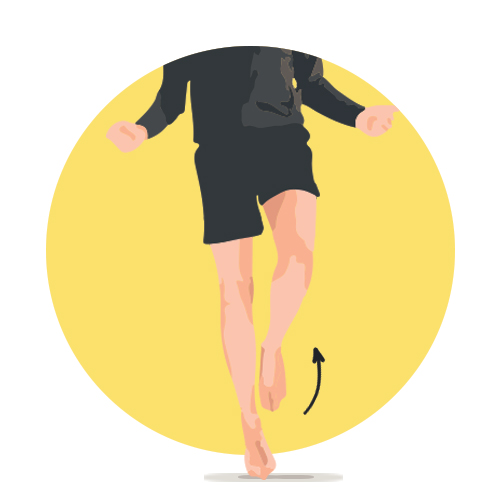
DUST OFF THAT SKIPPING ROPE
It's not just your old photo albums or videos that need to be dusted off. The skipping rope in your garage will quickly become your best friend. Why? Because you can use it to imitate the initiation of the step or stride of a hiker or runner. Your calves will also be recruited during this exercise.
As a recommendation: stand with or without a skipping rope (the "air skipping rope" also works), jump for 2 minutes on one foot, then on the other, and finally with both feet together.
Foot benefit: Dynamism
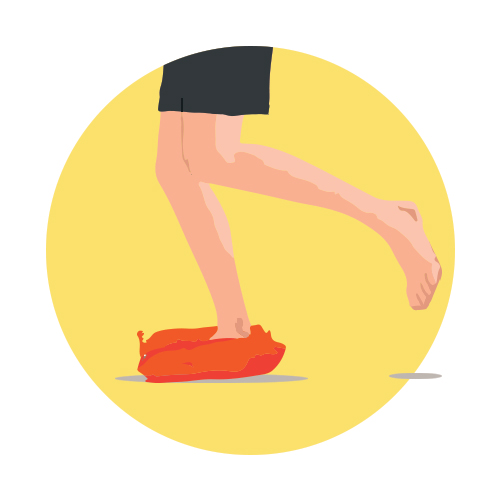 STAY BALANCED WITH PROPRIOCEPTION
STAY BALANCED WITH PROPRIOCEPTION
Proprioception is essential for balance: not necessarily the balance in your life, but your physical balance as you move. Its goal is to keep the neuromotor connection between your brain and feet as alert as possible. Hence, when you come across unstable ground, your feet maintain all their reflexes, vigilance, and responsiveness. Improving proprioception can—significantly—reduce the risk of a sprained ankle.
You can balance by standing on one foot then the other on a soft surface such as a cushion, sand, or bed. Your knee should be “locked.” To spice things up a little: close your eyes, bend your knee, lift your heel, sing, and lift your children.
Foot benefit: Balance, reactivity
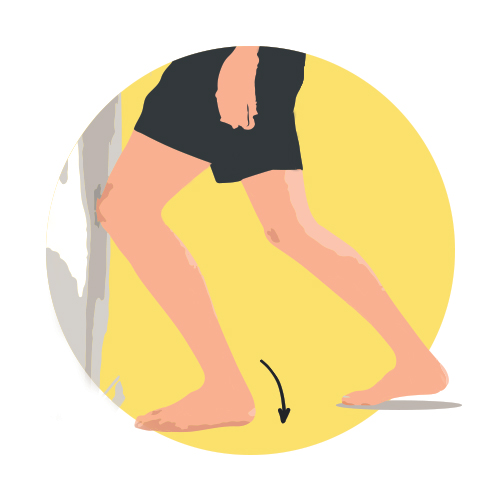
MOBILISE YOURSELF & YOUR JOINTS
The ankle is the linchpin in the foot. It is made up of a tangle of joints and is subjected to severe stress during all sporting activity, but it tends to quickly "rust" when you're immobile.
To ensure you don't forget your ankle, stand in front of a wall with one leg in front of the other, then try to touch the wall with the knee of your front leg, without taking your heel off the ground.
Foot benefit: Flexibility
STRETCH OUT FOR A BETTER RESTART
Have some free time? Use it to do all those little extras that maximise recovery. Stretching is key: relaxed muscles are efficient muscles.
We recommend two stretches:
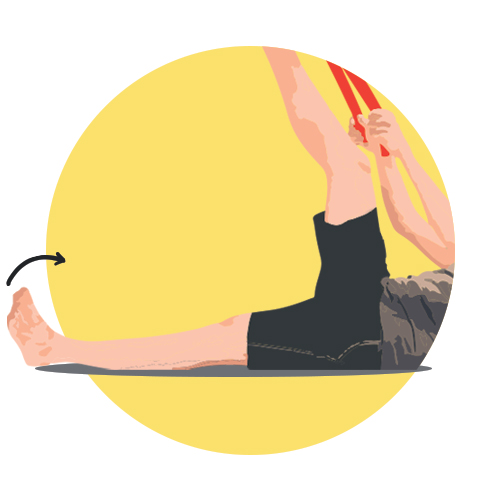
First exercice: Lie down on your back, raise one leg vertically using a band around the front of your foot. Bring the knee towards you when your heel is pointing at the ceiling. Your toes are taut.
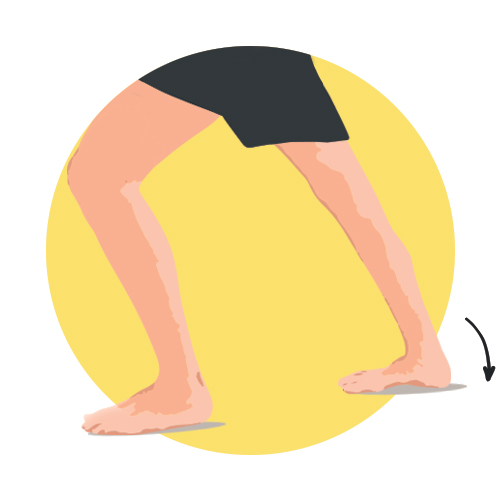
Second:Stand in front of a wall. Put one foot in front of the other, in a line perpendicular to the wall. Bring your body weight forward while preventing your heel from lifting off and your knee from bending back.
Foot benefit: Flexibility
WEAR PROPER SHOES, EVEN AT HOME
As part of optimising recovery, after a physical activity session wear our recovery sandals rather than slippers. These recovery sandals promote better blood circulation and so limit that feeling of “heavy legs” that can happen after exercise.
Foot benefit: Comfort
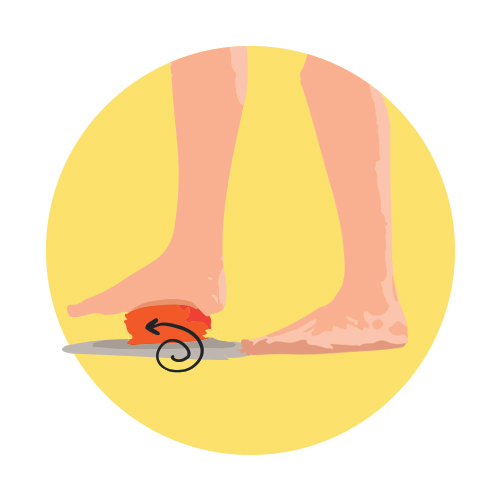
SELF-MASSAGE
If you can not go to the physiotherapist, feel free to do some self-massage which is also highly effective. You can do it using this handy little Blackroll foam roller or by applying a moisturiser to “tired” body areas.
Foot benefit: Energy, recovery
EASE INTO IT
One of the most important tips is definitely to return to your favourite hiking or running routes with cautious enthusiasm! Going back to physical activity too quickly and too hard after a period of inactivity will certainly lead to pain or injuries that could prevent you from hitting the trails. So, return to exercise gently, progressively and carefully, with the same vigilance you would use after an injury or time out of the game.
SHARE YOUR TRAINING
Share your trainings on Instagram with a post or a story using the #keepontraining !
Don't forget to identify us on your post @sidasyourfootcompany.
We will share on our page and into this article your most beautiful pictures!
Good luck to you all!


